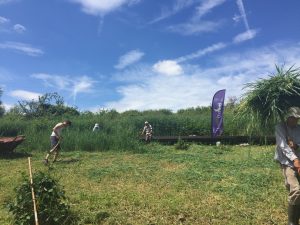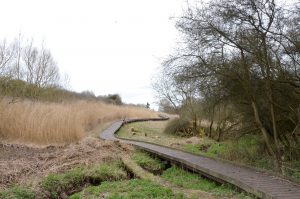My freshwater habitat: Andy Gunn, Chilswell Valley Fen, Oxfordshire
15th December 2022
For Project Manager Andy Gunn, Chilswell Valley Fen is a place to reflect and heal. It’s also somewhere he spends time with friends and family, including his young son, who enjoys searching for animals and ‘mythical creatures’ – like Andy did as a child.
There is something magical about Chilswell Valley. It almost feels like it shouldn’t be there. It’s so close to the city of Oxford – a tiny fragment of landscape trapped in time. Its mythology is also captivating: the name ‘Chilswell’ is believed to be derived from ‘Childs Well’ and legend has it that the water was once so pure that it could cure infertility and heal sick children.
The old track, which was once the main ‘road’ from Oxford to Abingdon, is adorned with ancient apple trees and twisted hedges. You can almost imagine the highwaymen waiting around the corner ready to take payment for passage.
Deep in the heart of this special place is Chilswell Valley Fen, which I discovered through work and return to as often as I can.
What makes Chilswell Valley such a special place for wildlife?
Chilswell Valley contain several different habitats, including oak and hazel woodland and limestone grassland, but it’s the alkaline fen that makes the site truly special. To reach it, you follow the boardwalk, which snakes through the reeds to transport you away from the city and towards the alkaline fen, which feels like a land that time forgot.
Oxford’s unique geology gives rise to several of these special alkaline fens, especially to the west of Oxford. The hills and valleys, which are dotted with these features, together form the Oxford Height’s West Conservation Target Area. The limestone-capped hills allow calcium-rich water to slowly percolate through to underground aquifers, which gradually form peat in the valleys.
Where springs rise to the surface at Chilswell Valley, calcium is precipitated out of the lime-rich water literally ‘petrifying’ vegetation, leaves and sticks that fall into the water. This creates tufa, which is similar to the limescale in a kettle (and the same principle). It’s these unique conditions that give rise to a bizarre and intriguing community of plants, such as Distant Sedge (Carex distans), Devil’s-bit scabious (Succisa pratensis) and Parsely Water-dropwort (Oenanthe lachenalii), as well as invertebrates, including two special species – the locally rare Fen Snout Soldierfly (Nemotelus pantherinus) and the cranefly Dicranomyia lucida.
Freshwater Habitats Trust is helping to protect Chilswell Valley Fen and other alkaline fens in Oxfordshire. In 2019, as part of our Saving Oxford’s Wetland Wildlife Project, the Trust commissioned the construction of a series of log dams in the heavily eroded and channelised Chilswell Stream to raise water levels and aid the re-wetting of the fen. Working with local ecologists Rod D’Ayala and Dr Judy Webb, as well as local volunteers, we applied the tried-and tested-blueprint for alkaline fen restoration, also used at Raleigh Park and Lye Valley.
We continue to work with the landowner Oxford City Council and partners like BBOWT and Natural England to develop best practice for the management of Oxfordshire’s Fens.
How did you discover Chilswell Valley Fen?
 Volunteers at Chilswell Fen in 2017
Volunteers at Chilswell Fen in 2017
I first visited the site in 2015, when the fen was thick with reeds and rank vegetation. At that time, I was working for the Berkshire, Buckinghamshire & Oxfordshire Wildlife Trust and, over the next few years, I worked with volunteers to scythe and remove the vegetation to allow smaller fen plants to re-establish. When we started, there were fewer than 10 species of plants in the fen but, with some management, it now boasts over 50 species of plants. I have very happy memories and a sense of pride for what we achieved at Chilswell Valley Fen.
What draws you back to Chilswell Valley Fen?
Over time, I developed a personal connection to Chilswell Valley Fen, and it has become the place I go to reflect and heal. If I’m feeling down or uncertain, a walk through the valley always helps to ground and calm me.
I’ve enjoyed sharing the site with others over the years and it’s now a go-to place when meeting friends. I also enjoy Chilwell’s proximity to Hinksey Heights Fen, which is a site I am now working on with Freshwater Habitats Trust, and there is a brilliant circular walk which takes in both of these wonderful reserves.
I also love taking my young son to Chilswell Valley with my partner. He started off visiting the site in a carrier when he was tiny, and now runs around searching for animals and mythical creatures – much like I did as a child.
When did you passion for freshwater wildlife start?
 Andy Gunn, Freshwater Habitats Trust
Andy Gunn, Freshwater Habitats Trust
From a very early age, I had an early fascination with newts and would go to the local park and look for them in the pond there. I became obsessed with the idea that newts were dragons!
As a child, I spent a lot of time in the stream that ran through my town, building dams, searching for tiny creatures and the elusive Bullhead fish (traditionally known by the name ‘Millers Thumb’ to reflect its appearance) Cottus gobio. Freshwater wildlife still captures my imagination and I can’t help being transported back to those first exciting encounters when I dip a net into a pond or stream to re-discover the intriguing world under the water.
Since Joining Freshwater Habitats Trust in January 2022, as Building Oxfordshire’s Freshwater Network Project Manager, I’ve been able to share my love of freshwater with many different people in Oxfordshire through our GroWet project and other initiatives.
What are your hopes for the future of Chilswell Valley Fen?
My main concern for Chilswell Valley Fen is protecting the clean water catchment. Alkaline fens have a surprisingly large catchment, and it is vital that this is protected from pollution and agricultural run-off. It’s the unseen influence that we humans have on these special places that is so difficult to communicate and protect. My dream for Chilswell would be to extend the nature reserve to include its catchment and protect it for future generations.
Andy Gunn is Project Manager for Building Oxfordshire’s Freshwater Network. Funded by the Government’s Green Recovery Challenge Fund, this project marks the start of work to create the Freshwater Network: a national initiative to build a network of wetter, wilder, cleaner, connected freshwaters to reverse the decline in freshwater biodiversity.
Chilswell Valley is part of BBOWT’s Wild Oxford Project and is owned and managed by Oxford City Council.
 The boardwalk, leading to Chilswell Valley Fen
The boardwalk, leading to Chilswell Valley Fen
